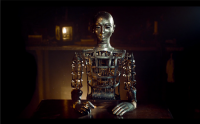








Al-Jazari described complex programmable humanoid automata amongst other machines he designed and constructed in the Book of Knowledge of Ingenious Mechanical Devices in 1206.His automaton was a boat with four automatic musicians that floated on a lake to entertain guests at royal drinking parties. His mechanism had a programmable drum machine with pegs (cams) that bump into little levers that operate the percussion. The drummer could be made to play different rhythms and different drum patterns if the pegs were moved around.According to Charles B. Fowler, the automata were a ""robot band"" which performed ""more than fifty facial and body actions during each musical selection.""
Al-Jazari also constructed a hand washing automaton first employing the flush mechanism now used in modern flush toilets. It features a female automaton standing by a basin filled with water. When the user pulls the lever, the water drains and the female automaton refills the basin.His ""peacock fountain"" was another more sophisticated hand washing device featuring humanoid automata as servants which offer soap and towels. Mark E. Rosheim describes it as follows: ""Pulling a plug on the peacock's tail releases water out of the beak; as the dirty water from the basin fills the hollow base a float rises and actuates a linkage which makes a servant figure appear from behind a door under the peacock and offer soap. When more water is used, a second float at a higher level trips and causes the appearance of a second servant figure — with a towel!"" Al-Jazari thus appears to have been the first inventor to display an interest in creating human-like machines for practical purposes such as manipulating the environment for human comfort.
Villard de Honnecourt, in his 1230s sketchbook, show plans for animal automata and an angel that perpetually turns to face the sun. At the end of the thirteenth century, Robert II, Count of Artois built a pleasure garden at his castle at Hesdin that incorporated several automata as entertainment in the walled park. The work was conducted by local workmen and overseen by the Italian knight Renaud Coignet. It included monkey marionettes, a sundial supported by lions and ""wild men"", mechanized birds, mechanized fountains and a bellows-operated organ. The park was famed for its automata well into the fifteenth century before it was destroyed by English soldiers in the sixteenth century.
The Chinese author Xiao Xun wrote that when the Ming Dynasty founder Hongwu (r. 1368–1398) was destroying the palaces of Khanbaliq belonging to the previous Yuan Dynasty, there were—amongst many other mechanical devices—automatons found that were in the shape of tigers.